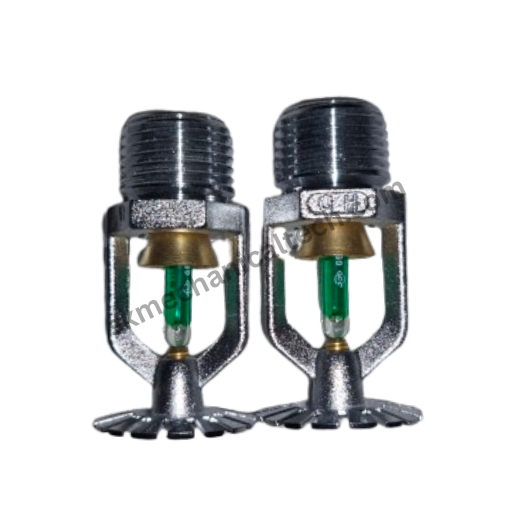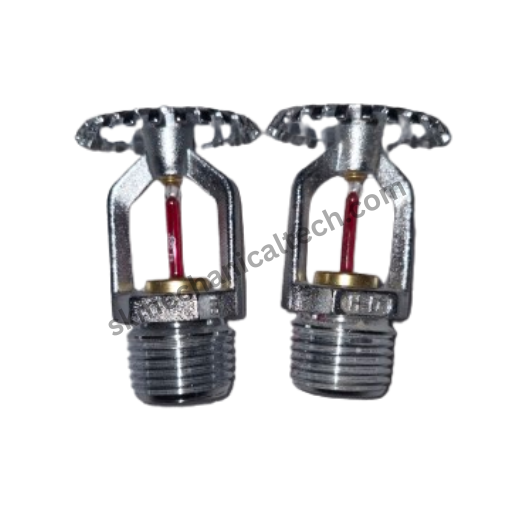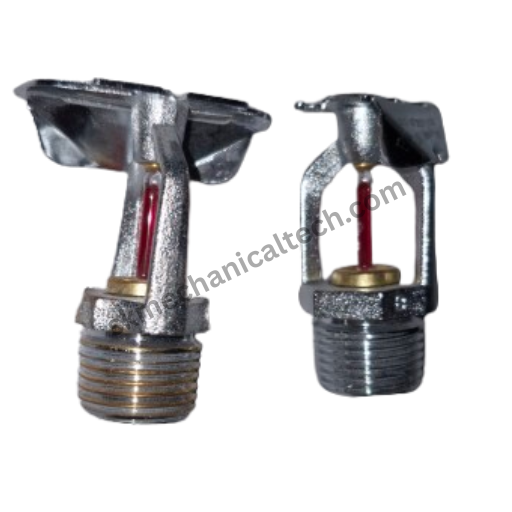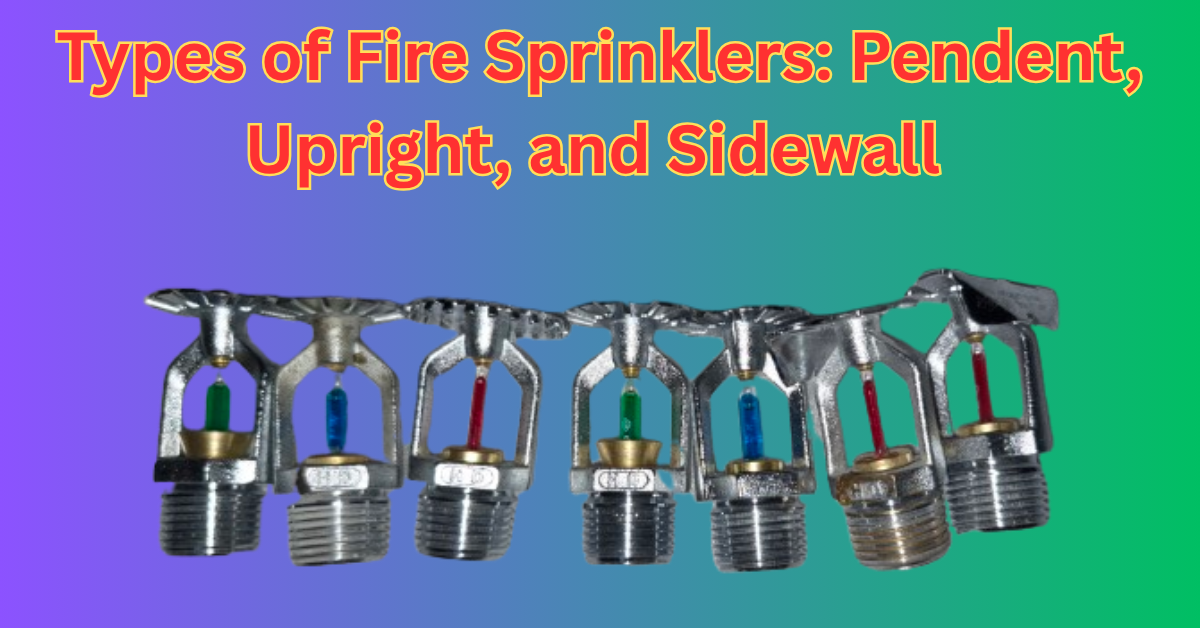Types of fire sprinklers, such as pendent, upright, and sidewall, play a vital role in fire protection systems. These sprinkler types are designed to detect heat and activate automatically, releasing water to control or extinguish fires. In this blog post, we will explore the workings, specifications, and best applications of each sprinkler type.
1. Pendant Sprinkler in Fire Protection Systems
Description:
Pendant sprinklers are the most commonly used type. They are installed in ceilings and hang downwards.

Specifications:
- Mounting Position: Suspended from the ceiling
- Spray Pattern: Circular pattern directed downward
- Temperature Rating: Typically ranges from 57°C to 107°C (135°F to 225°F)
- Finish Options: Brass, chrome, white, or custom finishes
- K-Factor: Commonly K5.6 or K8.0
Working:
When the ambient temperature around the sprinkler reaches the activation point (due to fire heat), the heat-sensitive glass bulb bursts or the fusible link melts. This opens the sprinkler head, allowing water to spray downward over the protected area in a circular pattern.
Common Applications:
- Offices
- Schools
- Residential apartments
- Commercial buildings
2. Upright type of fire sprinkler head
Description:
Upright sprinklers are designed to be installed above the piping system, usually in exposed or industrial areas.

Specifications:
- Mounting Position: Mounted vertically, pointing upward
- Spray Pattern: Upward spray deflected downward by a deflector
- Temperature Rating: 57°C to 107°C (135°F to 225°F)
- Finish Options: Mostly brass
- K-Factor: Typically K5.6, K8.0, or higher for industrial applications
Working:
When activated by heat, water shoots upward and is then deflected downward by the sprinkler’s special deflector plate, ensuring full coverage under obstructions like beams or equipment.
Common Applications:
- Warehouses
- Industrial factories
- Parking garages
- High-ceiling areas with obstructions
3. Sidewall Sprinkler
Description:
Sidewall sprinklers are installed on walls, allowing them to protect rooms or hallways where ceiling access is limited.

Specifications:
- Mounting Position: Horizontal installation on walls
- Spray Pattern: Semi-circular pattern out and down from the wall
- Temperature Rating: 57°C to 107°C
- Finish Options: Chrome, white, or decorative covers
- K-Factor: Typically K5.6 or K4.2
Working:
Sidewall sprinklers discharge water in a semicircular pattern that extends away from the wall and slightly downward. They are designed for spaces where ceiling piping is not feasible or where aesthetics matter.
Common Applications:
- Hotel rooms
- Hallways and corridors
- Small offices
- Residential rooms with finished ceilings
Read more—
- 🔥 फायरफाइटिंग स्प्रिंकलर कैलकुलेशन हिंदी में (Fire Sprinkler Calculation in Hindi)
- Step-by-Step Guide to Firefighting Diesel Pumps
- Fire Alarm Valve – Working, Types, Installation Guide & FAQs
Comparison Table
| Type | Mounting Location | Spray Direction | Ideal For |
|---|---|---|---|
| Pendent | Ceiling | Downward (circular) | Offices, homes, retail |
| Upright | Above piping | Upward then downward | Warehouses, industrial areas |
| Sidewall | Wall | Outward and downward | Corridors, hotels, offices |
Conclusion Choosing the right sprinkler type is essential for effective fire protection and system design. Each sprinkler head has a specific purpose depending on the building layout, ceiling construction, and fire risk level.
- Use pendant sprinklers for standard ceiling installations.
- Choose upright sprinklers for industrial areas with obstructions.
- Opt for sidewall sprinklers in tight or decorative spaces without ceiling access.
Before selecting sprinklers, always consult with a fire protection engineer and ensure compliance with NFPA standards or local building codes.
Types of Fire Sprinklers—Q&A Format
Q1: What are the different types of fire sprinklers?
A: The main types of fire sprinklers are
- Pendant Sprinklers
- Upright Sprinklers
- Sidewall Sprinklers
Each has a specific design and installation method depending on the layout and requirements of the building.
Q2: What is a pendant sprinkler?
A: A pendant sprinkler hangs from the ceiling and sprays water downward in a circular pattern. It is the most common type used in homes, offices, and commercial spaces.
Q3: How does a pendant fire sprinkler work?
A: When the room temperature reaches the rated activation point, the heat-sensitive bulb breaks, allowing water to flow and spray downward to suppress the fire.
Q4: Where is a pendant sprinkler used?
A: It is commonly used in:
- Residential buildings
- Offices
- Schools
- Hospitals
- Malls
Q5: What is an upright sprinkler?
A: An upright sprinkler is mounted above the pipe and sprays water upward. The water then hits a deflector, spreading downward in a circular pattern.
Q6: When is an upright fire sprinkler used?
A: Upright sprinklers are ideal for:
- Warehouses
- Industrial plants
- Areas with beam obstructions
- Parking basements
Q7: What is a sidewall sprinkler?
A: A sidewall sprinkler is installed on walls and sprays water in a horizontal, half-circle pattern. It’s perfect for narrow spaces where ceiling mounting isn’t possible.
Q8: Where is a sidewall sprinkler typically used?
A: Sidewall sprinklers are used in:
- Hotel rooms
- Corridors
- Offices with finished ceilings
- Residential rooms
Q9: What temperature ratings do fire sprinklers have?
A: Most sprinklers are rated between 57°C to 107°C (135°F to 225°F), depending on the environment and fire hazard level.
Q10: How do I choose the right type of fire sprinkler?
A: It depends on:
- The ceiling layout
- Obstructions like ducts or beams
- Aesthetic preferences
- Local fire safety codes (e.g., NFPA or IS)
Consulting a fire protection engineer is always recommended.
Q11: Why are there different fire sprinkler types?
A: Different sprinkler types ensure maximum coverage and effectiveness based on room design, fire risk, and installation possibilities.
Q12: Do all fire sprinklers activate at once?
A: No. Only the sprinkler closest to the fire activates, reducing water damage and improving fire control.
Q13: What are the standard K-factors in fire sprinklers?
A: Common K-factors include:
- K5.6 (80 metric)—for standard coverage
- K8.0 (115 metric)—for extended coverage or higher flow
- Larger K-factors (e.g., K11.2, K14) are used in industrial or high-ceiling areas.
The K-factor determines how much water flows through the sprinkler at a given pressure.
Q14: What standards govern fire sprinkler installation?
A: The primary international standard is NFPA 13 (National Fire Protection Association – USA). In India and other regions, IS 15105 and local fire codes are followed for design and installation.
Q15: Can I mix different types of fire sprinklers in one building?
A: Yes, but only when designed properly by a qualified fire protection engineer. Each area must meet coverage and pressure requirements based on the sprinkler type.
Q16: How often should fire sprinklers be inspected?
A: According to NFPA 25:
- Visual inspections: Quarterly
- Functional testing: Annually
- Obstruction/flow testing: Every 5 years
Always follow local regulations and the manufacturer’s recommendations.
Q17: What is the lifespan of a fire sprinkler?
A: Most fire sprinklers last 50+ years if well-maintained. However, sprinklers exposed to corrosion, paint, or damage should be replaced immediately.
Q18: Can pendant sprinklers be recessed or concealed?
A: Yes. Recessed and concealed pendant sprinklers are available and commonly used in modern interiors to maintain aesthetics while ensuring fire safety.
Q19: Do sidewall sprinklers require a deflector?
A: Yes. Sidewall sprinklers have a special built-in deflector to direct the spray in a horizontal or outward semi-circular pattern, ensuring coverage across the room width.
Q20: What causes fire sprinklers to malfunction?
A: Common causes include:
- Corrosion or rust
- Foreign materials blocking orifices
- Improper pressure
- Physical damage or paint over the head
Routine maintenance prevents most of these issues.
Q21: Are fire sprinklers heat or smoke activated?
A: Heat activated only. Fire sprinklers respond to rising temperatures, not smoke. This prevents false activations from cooking or incense smoke.
Q22: Can fire sprinklers be used outdoors?
A: Yes, but outdoor sprinklers must be:
- Rated for low temperatures
- Installed with antifreeze systems or dry pipe systems to prevent freezing in cold climates
Q23: How much area does one fire sprinkler cover?
A: According to NFPA:
- Standard coverage sprinkler: Up to 130–200 sq. ft (12–18 m²), depending on hazard and layout
- Extended coverage models: Up to 400 sq. ft. (37 m²)
Coverage depends on spacing, ceiling height, and hazard classification.
